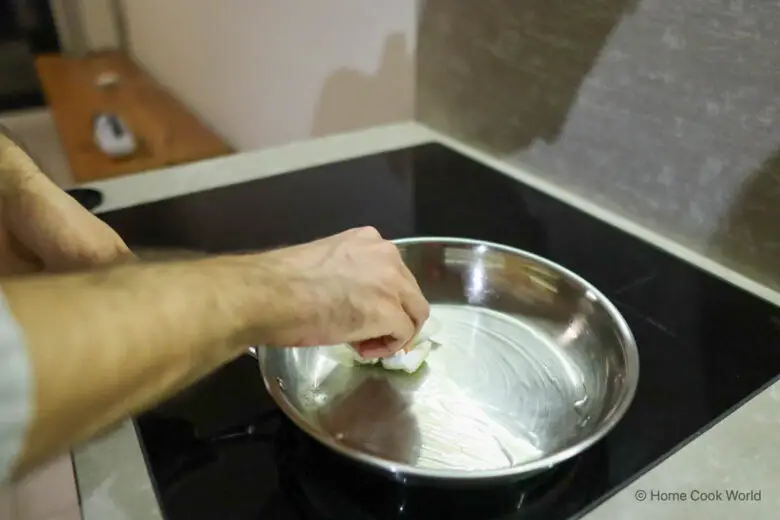“How can I keep salmon from sticking to my stainless steel frying pan?” This is a question I get asked every now and then, and it’s an easy answer!
If you don’t have a non-stick pan at home or you want better browning on your food than what non-stick or ceramic pans can give you, stainless steel is one of your options out there.
The problem is that salmon—and fish in general—is one of those high in protein, low in fat foods that stick way too easily to cookware made of stainless steel. Unless you’re using the proper technique, it can be hard to not have it stick all over your pan and break down into pieces.
In this post, I’m going to tell you about my technique to prevent salmon from sticking to stainless steel. It consists of three simple tricks that have so far worked for me every single time.
To keep salmon from sticking to your stainless steel pan, grease the bottom and sides of your pan with cooking oil and preheat it for 2-3 minutes. Cook the salmon skin-down for 3 ½ minutes before flipping it over to the other side using a spatula. When it’s fully cooked on one side, it will release itself from the pan.
I’m telling you; I’ve got this down almost to a science.
Here’s how it usually goes.
First, I grease my frying pan with cooking oil.
To do this, I usually drizzle 2-3 tablespoons of cooking oil in my frying pan. Then, I take a paper towel and use it to wipe the oil all over the bottom and sides of my pan.
The oil acts as a coating between the bare-steel surface of the pan and the otherwise-sticky salmon fillet.
Second, I preheat the pan over medium-high heat for 2-3 minutes.
Stainless steel cookware has a surface that looks smooth to the naked eye. But take a closer look at it under a microscope, and you’ll see that it’s covered with thousands of holes and valleys that expand and contract as the steel heats up and cools down.
Giving your pan enough time to preheat allows its cooking surface to stabilize and get coated by the oil.
Third, I put the salmon fillet in the pan skin-down, letting it cook for 3-4 minutes before flipping it over (with the help of a fork or metal spatula) to the other side.
The two secret ingredients that you won’t see in any recipe are time and patience. When you give the salmon enough time to cook without trying to move it around, it will eventually release itself from the pan.
At that stage, flipping it over to the other side becomes easy (keep in mind that you may still need a little help from your fork or spatula to get it completely unstuck).
The result?
A perfectly cooked, golden brown, crispy salmon without the hassle of having to scrub off bits and pieces of it from your pan.



What’s the Best Oil for Pan-Frying Salmon?
One of your most important choices when pan-frying salmon is what cooking oil to use.
Every oil has a smoke point; the temperature at which it stops to glisten and shimmer, and starts to break down and burn. When you heat an oil past its smoke point, it starts to form unhealthy compounds and emit blue fumes.
Simply said, you should always tailor your choice of oil to the cooking method—and never heat the vegetable oil or cooking fat in your frying pan past its smoke point.
For pan-frying salmon, I recommend using avocado oil or rice bran oil. They have a higher smoke point than most of the other oils and fats in your kitchen (including olive oil and butter).
Is It Better to Cook Salmon on the Stove or in the Oven?
We all love salmon. But what’s the best way to prepare it? Should you pan-fry it on your stove or bake it in the oven?
The answer depends on what you want to achieve. Pan-frying (also known as “searing”) salmon seals in flavor and produces generally juicer fish. Baked salmon is drier, but also crispier and flakier than seared salmon.
Some home cooks prefer to combine the “best of both worlds” by searing the salmon for 1-2 minutes over high heat on the cooktop to form a browned exterior, then finishing it off for 15-20 minutes in the oven, preheated to 350°F (176°C), for a flaky interior.
In Conclusion
Try my technique for cooking salmon out, and let me know how it worked for you. Did the salmon still stick to your pan? Was it at least easier for you to get it unstuck with a spatula?
I know cooking fish with stainless steel can be tricky, but the browning and charring you get on a fillet is so much better than what you’d get if you cooked in non-stick.
